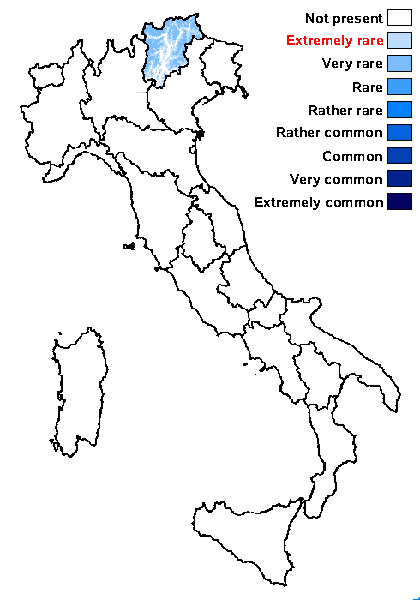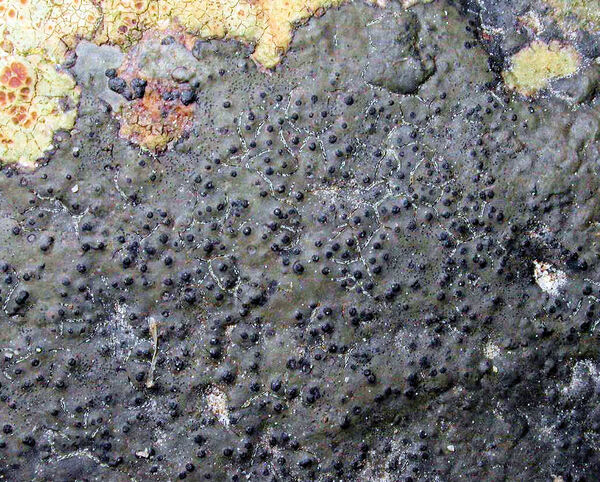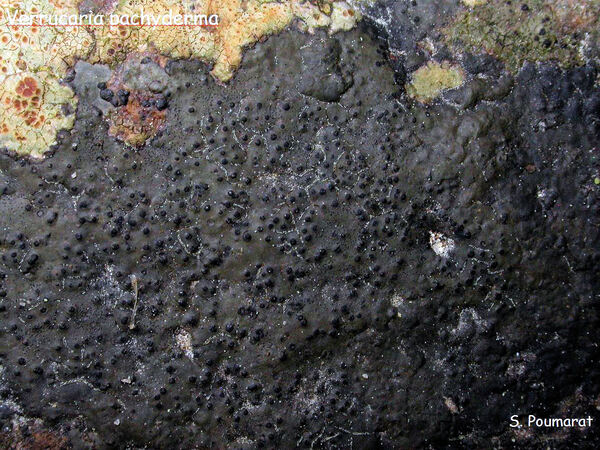Hydropunctaria scabra (Vězda) C. Keller, Gueidan & Thüs
Taxon, 58, 1: 194, 2009. Basionym: Verrucaria scabra Vězda - Folia Geobot. Phytotaxon. 5, 3-4: 308, 1970
Synonyms:
Distribution: N - TAA (Nascimbene & al. 2022).
Description: Thallus crustose, episubstratic, (35-)50-150 μm thick, subgelatinous when wet, mostly verrucose, continuous, dull green to dark grey-green or dark green, rarely with sparse, small black dots, delimited by a whitish prothallus or, from conspecific thalli, by black lines. Cortex paraplectenchymatous, poorly differentiated, the cell walls dull green; photobiont cells arranged in vertical rows; medulla paraplectenchymatous, the upper part with small, upwardly projecting areas of dark cells appearing as more or less discrete dots in section, the lower part with black patches which often merge to form a black basal layer. Perithecia completely immersed in the thalline warts, covered with a thalline layer, usually visible as black dots, more rarely slightly projecting, the apex appearing as a whitish ring or as a black, 0.2-0.3 m wide, often roughened disc. Involucrellum well-developed, tightly adpressed to exciple, often reaching the black basal layer; exciple often difficult to distinguish from the involucrellum, 275-290 μm across, colourless or partly brown; hamathecium of periphyses and periphysoids, interascal filaments absent, the periphyses 20-30 x 1.5-3 μm; hymenial gel hemiamyloid, I+ red (I+ blue at very low concentrations of I), K/I+ blue. Asci 8-spored, clavate, I-, fissitunicate, the wall thickened above, with an ocular chamber, dehiscent by extrusion of an endotunica to form a delicate rostrum, Verrucaria-type. Ascospores 1-celled, hyaline, oblong-ellipsoid to ellipsoid, (10-)14-18(-21.5) x (5.2-)7.5-9(-10.5) μm, often with truncated poles, without a perispore. Pycnidia black, immersed. Conidia straight or slightly curved, 3.5-5 x 1-1.2 μm. Photobiont chlorococcoid. Spot tests: K-, C-, KC-, P-, UV-. Chemistry: without lichen substances.Note: on siliceous rocks in the amphibious zone of streams, often near rapids and waterfalls, but also on lake shores; widespread in Europe but only locally abundant; with a few records from the Alps, but perhaps overlooked or misidentified as H. rheitrophila.
Growth form: Crustose
Substrata: rocks
Photobiont: green algae other than Trentepohlia
Reproductive strategy: mainly sexual
Periodically submerged (e.g. in creeks)
Commonnes-rarity: (info)
Alpine belt: very rare
Subalpine belt: very rare
Oromediterranean belt: absent
Montane belt: extremely rare
Submediterranean belt: absent
Padanian area: absent
Humid submediterranean belt: absent
Humid mediterranean belt: absent
Dry mediterranean belt: absent

Predictive model
Herbarium samples
Growth form: Crustose
Substrata: rocks
Photobiont: green algae other than Trentepohlia
Reproductive strategy: mainly sexual
Periodically submerged (e.g. in creeks)
Commonnes-rarity: (info)
Alpine belt: very rare
Subalpine belt: very rare
Oromediterranean belt: absent
Montane belt: extremely rare
Submediterranean belt: absent
Padanian area: absent
Humid submediterranean belt: absent
Humid mediterranean belt: absent
Dry mediterranean belt: absent

Predictive model
| Herbarium samples |
 INDEX FUNGORUM
INDEX FUNGORUM
 GBIF
GBIF
 DOLICHENS
DOLICHENS





